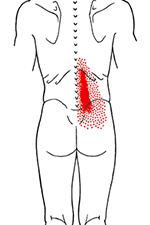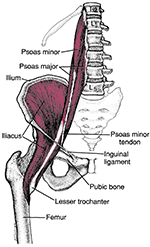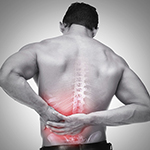
Chronic Low Back Pain – Psoas
Psoas major is your primary hip flexor. It can cause a well defined and excruciating pain pattern. The two psoas muscles and ileacus together are called iliopsoas.
Dysfunction on either side will cause you pain on that side in a diffuse spot in the lower back. There are seven primary muscle groups that refer pain into the low back. However, this is one of two found on the front of the body.
The first step in untangling any case of lower back pain is to confirm or eliminate more serious spinal injury or degeneration as a cause. After consultation with trained medical professionals, you can focus on the soft tissue aspects of chronic lower back pain – psoas is just one them.
Trigger points in the psoas muscle cause chronic low back pain. Problems with other muscles often activate iliopsoas secondarily. For instance, a fall or sudden overload can activate psoas simultaneously with these other muscles.
Prolonged flexion can activate iliopsoas trigger points. For example, sitting with the hips flexed for a long time shortens these muscles and promotes myofascial dysfunction and trigger points in the psoas.
In fact, sustained immobility in any seated position will reduce circulation and aggravate iliopsoas trigger points.
Psoas has a helper. The rectus femoris muscle is the only one of the quads that crosses the hip. It assists in hip flexion. Tight bands in this muscle prevent full hip extension and can make trigger points in the iliopsoas worse. See the article on Knee Pain for rectus femoris self care.
What Makes This Type of Low Back Pain Worse?
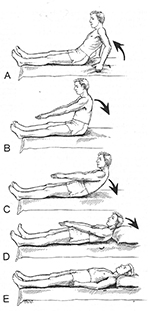 Some types of skeletal variations can also make myofascial dysfunction of the psoas worse. A trained professional should evaluate these.
Some types of skeletal variations can also make myofascial dysfunction of the psoas worse. A trained professional should evaluate these.
A soft mattress that sags in the middle aggravates tension in the low back muscles. There are many types of mattresses available; what you replace it with is a largely a matter of taste but we recommend a firm mattress.
The overload caused by the repetitive vigorous contractions of situps and improperly performed crunches can increase dysfunction of the iliopsoas. Consider the eccentric contraction of slow sit-backs as pictured or some of the many plank variations instead.
Forceful attempts to lengthen the hamstrings by reaching strenuously for the toes can cause sudden overload of iliopsoas. Instead, you can avoid the low back pain that this causes by performing more gentle, passive stretches of the hamstrings.
More importantly, ongoing issues with the iliopsoas can cause distorted posture that overloads back and neck muscles, perpetuating trigger points and dysfunction in them.
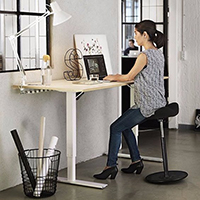 How Can I Help Myself With Low Back Pain?
How Can I Help Myself With Low Back Pain?
When sitting for prolonged periods, try to modify your seating so that your the angle of your hips is more open. The tilting stool pictured is just one of a variety of ways you can achieve this. This type of seating is a better alternative than standing for many office workers. When driving, cruise control will provide you the opportunity to move a bit over extended distances.
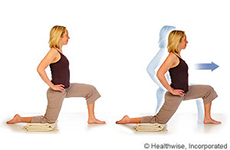 If you sleep on your back a pillow under the knees will provide gentle flexion at the hip and reduce stress on the iliopsoas. When sleeping on the side it is important to avoid sleeping in the fetal position, with the hips sharply flexed.
If you sleep on your back a pillow under the knees will provide gentle flexion at the hip and reduce stress on the iliopsoas. When sleeping on the side it is important to avoid sleeping in the fetal position, with the hips sharply flexed.
There are many ways to stretch the iliopsoas. One easy and safe way that requires no equipment is the low lunge. As you can see, for this purpose, the movement of is forward (not “deeper”) to provide gentle extension of at the hip for the trailing leg. Some YouTube videos provide is a good illustration of a safe active psoas stretch with warmup and a deep low lunge.
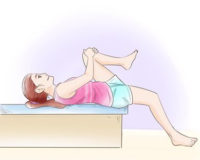
Many people do better with a passive psoas stretch, often done by letting the leg hang off the end of a table, extending the hip. We prefer supporting the flexed leg on a stool or similar rather than pulling it to the chest. Put a pillow on the floor for your foot. Ideally the height of the table allows you to barely touch a pillow when you begin. It should sink in thoroughly as the psoas releases.
Associated trigger points can develop in the referral zone of a primary TrP. This can be because the muscle is related in a functional way or because the muscles share innervation or proximity. Therefore, muscles in the referral zone of the iliopsoas or muscles that refer into it should be considered.
For example, muscles that lie within the referral zone of the iliopsoas include the QL, paraspinals, glute, adductors, quads, serratus posterior inferrior and sartorius.
On the other hand, the QL, rectus abdominis, pyramidalis, obliques and paraspinal muscles have referral zones that include the iliopsoas.
The iliopsoas muscles do not usually develop myofascial dysfunction alone. They are often involved with other muscles.
The antagonists of iliopsoas are likely to develop TrPs, including the gluteus maximus, hamstrings, and adductor magnus muscles.
However, synergists of the iliopsoas often develop TrPs as well, including the QL, rectus abdominis, rectus femoris, TFL, pectineus, paraspinal and opposite iliopsoas muscles.
The iliopsoas is the prime mover of hip flexion, and is the strongest of the hip flexors (others are rectus femoris, sartorius, and tensor fasciae latae). The iliopsoas is important for standing, walking, and running.
The psoas major is the primary hip flexor. assisted by the psoas minor and iliacus, rectus femoris (one of four quads), the adductors and handful of other muscles. It is also an important postural muscle.
When standing or sitting psoas is important for maintaining upright posture. Portions of psoas are continuous with the quadratus lumborum muscle. Together, these muscles are two of the most important “core” muscles in the low back.
The iliacus and psoas major perform different actions when postural changes occur.
Psoas Major
The psoas major joins the upper body and the lower body, the axial to the appendicular skeleton, the inside to the outside, and the back to the front. As part of the iliopsoas, psoas major contributes to flexion in the hip joint. On the lumbar spine, unilateral contraction bends the trunk laterally, while bilateral contraction raises the trunk from its supine position. In addition, attachment to the lesser trochanter, located on the postero-medial aspect of the femur, causes lateral rotation and weak adduction of the hip.
It forms part of a group of muscles called the hip flexors, whose action is primarily to lift the upper leg towards the body when the body is fixed or to pull the body towards the leg when the leg is fixed.
For example, when doing a sit-up that brings the torso (including the lower back) away from the ground and towards the front of the leg, the hip flexors (including the iliopsoas) will flex the spine upon the pelvis.
Because of the frontal attachment on the vertebrae, rotation of the spine will stretch the psoas.
Iliacus
In open-chain exercises, as part of the iliopsoas, the iliacus is important for lifting (flexing) the femur forward (e.g. front scale). In closed-chain exercises, the iliopsoas bends the trunk forward and can lift the trunk from a lying posture (e.g. sit-ups, back scale) because the psoas major crosses several vertebral joints and the sacroiliac joint. From its origin in the lesser pelvis the iliacus acts exclusively on the hip joint.
The iliopsoas refers to the joined psoas and the iliacus muscles. The two muscles are separate in the abdomen, but usually merge in the thigh. As such, they are usually given the common name iliopsoas. The iliopsoas muscle joins to the femur at the lesser trochanter. It acts as the strongest flexor of the hip.
It is a typical posture muscle dominated by slow-twitch red type 1 fibers. Since it originates from the lumbar vertebrae and discs and then inserts onto the femur, any structure from the lumbar spine to the femur can be affected directly. A short and tight iliopsoas often presents as externally rotated legs and feet.
Structure
The iliopsoas muscle is a composite muscle formed from the psoas major muscle, and the iliacus muscle. The psoas major originates along the outer surfaces of the vertebral bodies of T12 and L1-L3 and their associated intervertebral discs. The iliacus originates in the iliac fossa of the pelvis.
The inferior portion below the inguinal ligament forms part of the floor of the femoral triangle.
Psoas Major (Psoas)
The psoas major joins the upper body and the lower body, the axial to the appendicular skeleton, the inside to the outside, and the back to the front.[7] As part of the iliopsoas, psoas major contributes to flexion in the hip joint. On the lumbar spine, unilateral contraction bends the trunk laterally, while bilateral contraction raises the trunk from its supine position. In addition, attachment to the lesser trochanter, located on the postero-medial aspect of the femur, causes lateral rotation and weak adduction of the hip.
It forms part of a group of muscles called the hip flexors, whose action is primarily to lift the upper leg towards the body when the body is fixed or to pull the body towards the leg when the leg is fixed.
For example, when doing a sit-up that brings the torso (including the lower back) away from the ground and towards the front of the leg, the hip flexors (including the iliopsoas) will flex the spine upon the pelvis.
Owing to the frontal attachment on the vertebrae, rotation of the spine will stretch the psoas.
Psoas Minor
Psoas minor originates from the vertical fascicles inserted on the last thoracic and first lumbar vertebrae. From there, it passes down onto the medial border of the psoas major, and is inserted to the innominate line and the iliopectineal eminence. Additionally, it attaches to and stretches the deep surface of the iliac fascia and occasionally its lowermost fibers reach the inguinal ligament. Variations occur, however, and the insertion on the iliopubic eminence sometimes radiates into the iliopectineal arch.
The psoas major unites with the iliacus at the level of the inguinal ligament and crosses the hip joint to insert on the lesser trochanter of the femur. The iliopsoas is classified as an “anterior hip muscle” or “inner hip muscle”. The psoas minor does contribute to the iliopsoas muscle.
The psoas minor is considered inconstant and is often absent, only being present in about 40% of human specimens studied. It has an average length of about 24 cm, of which about 7.1 cm is muscle tissue and about 17 cm is tendon.
Iliacus
The iliacus arises from the iliac fossa on the interior side of the hip bone, and also from the region of the anterior inferior iliac spine (AIIS). It joins the psoas major to form the Iliopsoas, as which it proceeds across the iliopubic eminence through the muscular lacuna to its insertion on the lesser trochanter of the femur. Its fibers are often inserted in front of those of the psoas major and extend distally over the lesser trochanter.
Extra - Janda's Lower Crossed Syndrome
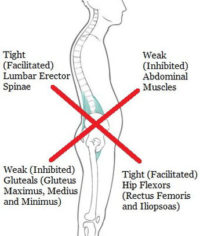 Myofascial dysfunction in the iliopsoas often occurs as part of a pattern with other hip muscles acting on the hip. This has been called Lower Crossed Syndrome.
Myofascial dysfunction in the iliopsoas often occurs as part of a pattern with other hip muscles acting on the hip. This has been called Lower Crossed Syndrome.
The "cross" is an imbalance between four different groups of muscles; the iliopsoas/spinal erectors, which are too tight, and the glutes/abdominals, which are too weak.
Correcting this requires treatment and stretching of the hip flexors and spinal erectors. However, this is only addresses half of the problem. It is also necessary to strengthen the glutes and certain abdominal muscles to restore balance to this key area.
How Can a Therapist Help You With Low Back Pain?
In most cases of chronic low back pain – psoas trigger point dysfunction rarely occurs in isolation. Many people are challenged by the complex relationships of the psoas to other muscles that act on the hip and and low back.
Psoas does not like to be be stretched forcefully. Because most of the muscle lies deep in the abdomen, a skilled therapist can often access it more effectively.

